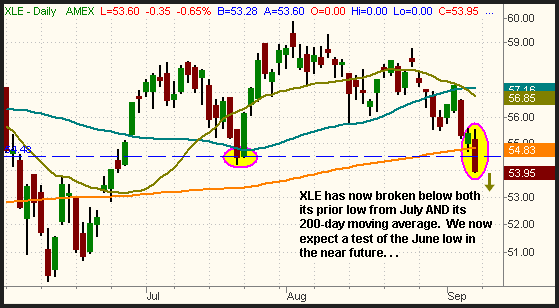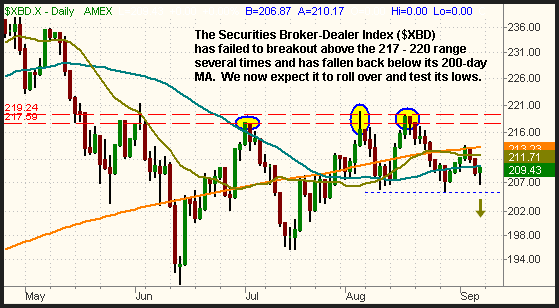As anticipated, support of their 20-day moving averages caused the major indices to bounce last Friday, but volume dropped off significantly. Both the Nasdaq Composite and Dow Jones Industrial Average gained 0.5%, while the S&P 500 recovered 0.4% of the previous day's loss. The small-cap Russell 2000 and S&P Midcap 400, two accurate barometers of the stock market's health, closed higher by only 0.3% and 0.1% respectively. It was a choppy session in which the broad market secured its gains by grinding higher in an indecisive fashion.
Turnover fell across the board, a situation that commonly occurs in choppy trading days. In the Nasdaq, total volume sharply declined by 20%. Volume in the NYSE was 9% lower than the previous day's level. After two straight "distribution days" (losses on higher volume), it obviously would have been better if stocks roared back on higher volume, but that was clearly not the case. The volume pattern of the market throughout last week points to further downside in the short-term. Market internals were positive, but not by a wide margin. In both exchanges, advancing volume exceeded declining volume by a ratio of approximately 3 to 2.
The S&P Select Energy SPDR (XLE), which we have discussed several times over the past two weeks, slid 2.5% and broke below support of its 200-day moving average last Friday. It was the first close below its 200-MA since June 22 of this year. Recall that the first sign of trouble occurred when XLE failed to hold above its August 2 breakout for more than a day, then sold off below its 20-day moving average eight days later. When XLE fell below its 50-day moving average on August 30, the downward momentum really began to pick up, but not before giving traders a nice short sale entry point when it rallied back into new resistance of its 50-day MA on August 5. Now that XLE has closed firmly below its 200-day moving average, odds are good it will soon test support of its June low before attempting any kind of a meaningful recovery. Looking at the daily chart below, notice how the break of the 200-day MA coincided with a break of the prior closing low from July:

Again, we remain short XLE in the Morpheus Capital hedge fund from a price of 56.48, but it is not an "official" trade entry that will be tracked like the others. Advanced traders should still consider short selling XLE into any light to moderate strength, but initiating a new short position at the current level does not provide the best risk/reward ratio.
One sector we have not recently discussed that is setting up for a potential trade entry is the Securities Broker-Dealer Index ($XBD). Since June, the sector has been oscillating on both sides of its 200-day moving average, but we feel it will soon make a significant downward move, away from its 200-MA:

As the dashed horizontal lines on the chart above illustrates, the sector has been unable to rally above resistance of the 217 to 220 range. Since August, the $XBD has tried twice, but failed both times. As such, the bulls are getting tired and the index has drifted back below its 200-day MA. On September 5, the $XBD attempted to recover back above its 200-MA, but the resistance stopped it dead in its tracks. From here, each subsequent rally attempt should get weaker until support of the 205 price level is broken. If the August 29 low is violated, a short sale in the broker-dealer sector will become a very positive risk/reward trade setup. In addition to individual stocks, there are now two different ETFs that are tied to the sector. They are the iShares DJ U.S. Broker-Dealer (IAI) and the StreetTRACKS Capital Markets (KCE). Because both of them are new ETFs, they do not yet trade a lot of shares on an average day, but that should not deter you from trading them.
Unlike individual stocks, in which liquidity can greatly affect how a stock trades, remember that all exchange traded funds are synthetic instruments. As such, the amount of average daily volume that an ETF trades is, for the most part, irrelevant. Even if a particular ETF had no buyers or sellers for several hours, the bid and ask prices would continue to move in correlation with the market value of the ETF that is derived from the prices of the underlying stocks. The only thing you need to be aware of is that ETFs with a low average daily volume may sometimes have slightly wider spreads between the bid and ask prices. If this is a concern, you can simply use limit orders, but it really should not matter much unless you are a daytrader who is only looking to gain a few pennies on the trade. We don't mind paying 5 cents more on a trade that has a goal of several points or more.
Last Friday was an "inside day" for the broad market, which means that each of the major indices traded completely within their respective intraday trading ranges of the previous day. As such, the technical picture of the broad market remains the same as our last analysis. To refresh your mind, the S&P, Dow Jones, and Nasdaq each remain below the new resistance of their prior uptrend lines. Below, the 20-day moving averages acted as minor support that helped the market bounce on Friday. If the major indices were to rally back above resistance of their prior uptrend lines, it would be quite bullish. But a more likely scenario, at least in the near-term, is for the S&P, Dow, and Nasdaq to break below support of their lows of the past two days. Just like water running down a hill, stocks simply follow the path of least resistance. In this case, it would require a lot more upward momentum to rally back above the prior uptrend lines than for the indices to break below their 20-day moving averages. If the latter happens, expect to see a rapid move down to their 50-day moving averages, at which point stocks would likely attempt a significant bounce. Support of the two-day lows is at the following levels: S&P 500 - 1,292, Nasdaq Comp. - 2,149, Dow Jones - 11,323.
Deron Wagner is the Founder and Head Trader of both Morpheus Capital LP, a U.S. hedge fund, and Morpheus Trading Group, a trader education firm launched in 2001 that provides daily technical analysis of the leading ETFs and stocks. For a free trial to the full version of The Wagner Daily or to learn about Wagner's other services, visit MorpheusTrading.com or send an e-mail to deron@morpheustrading.com.